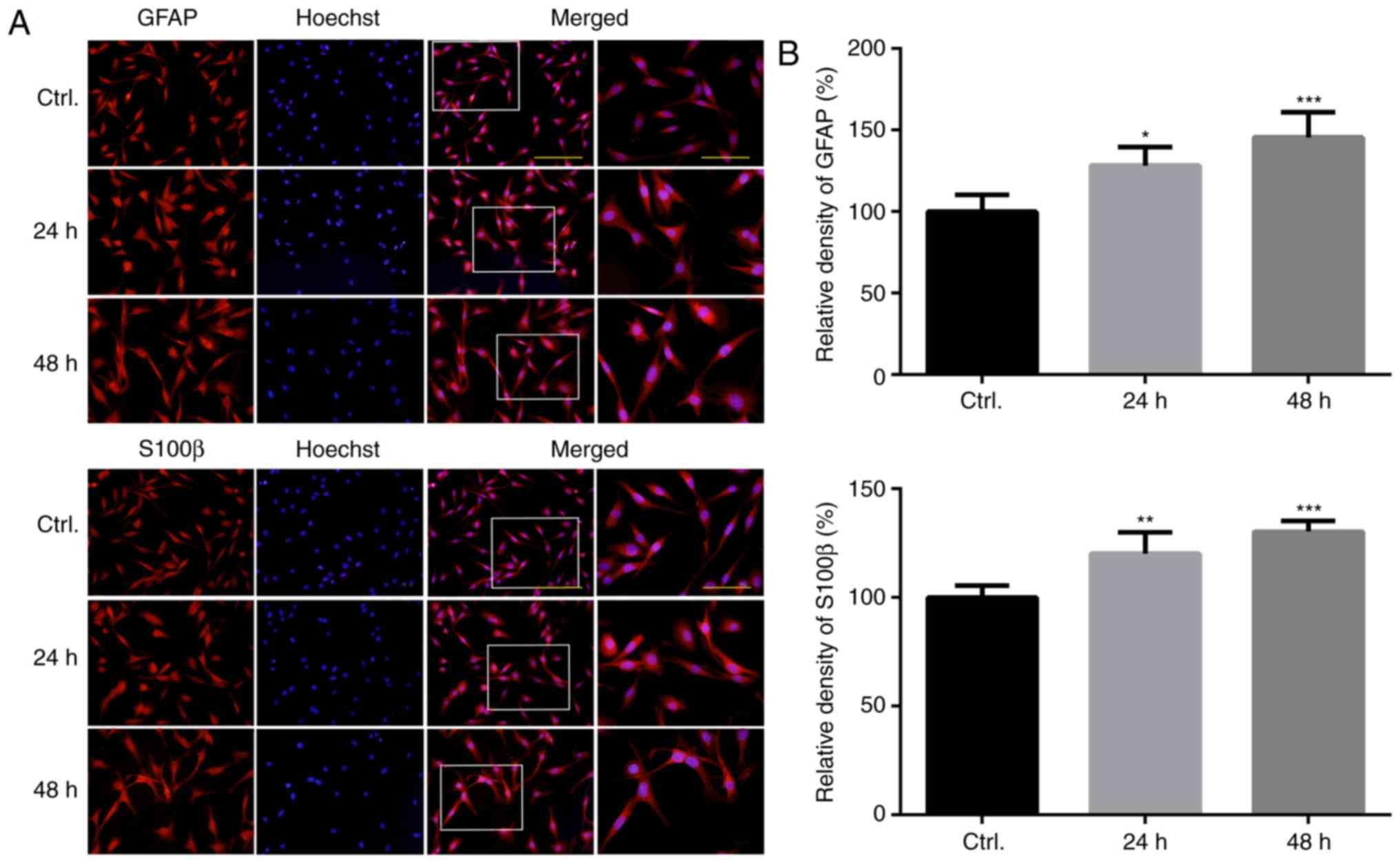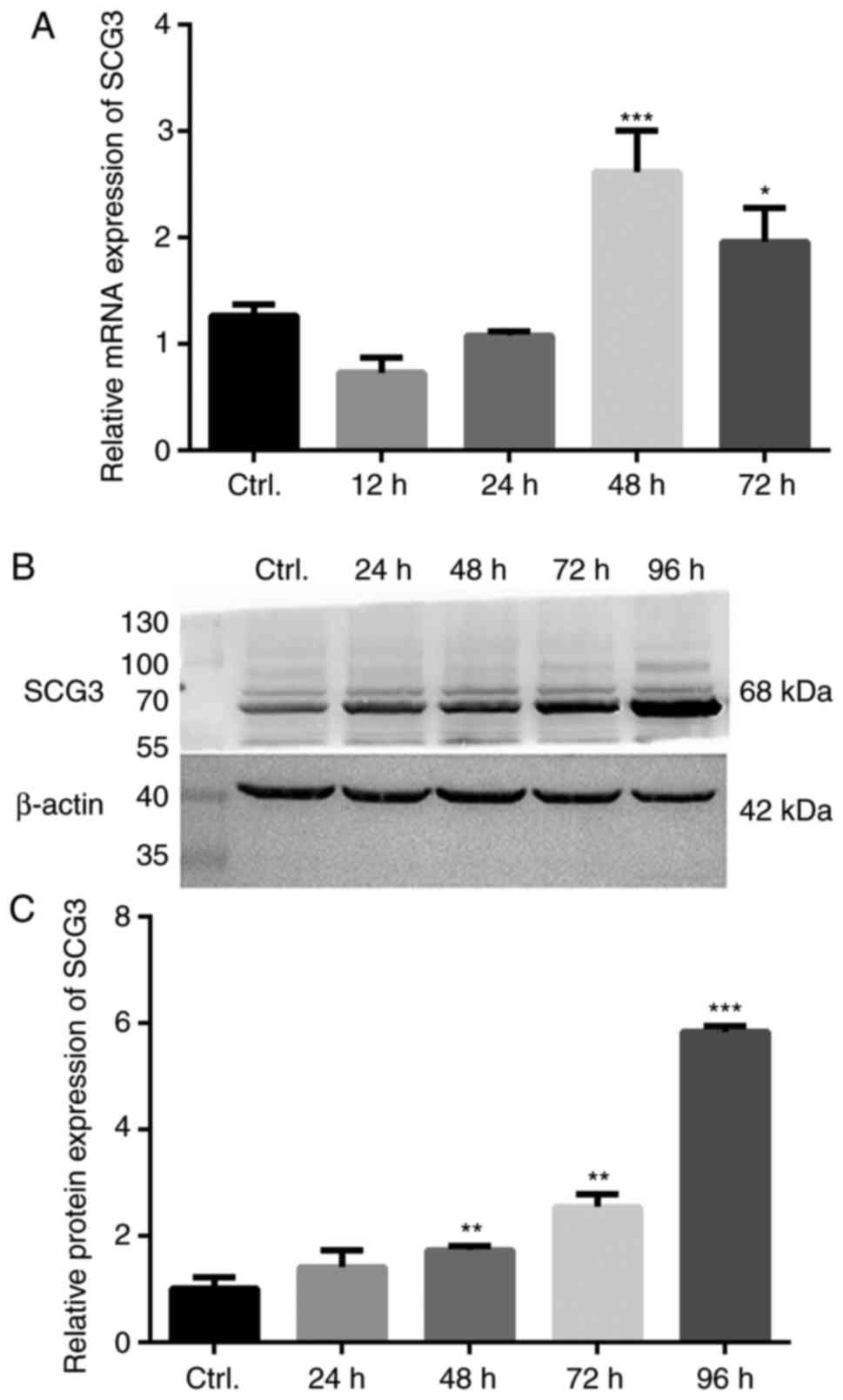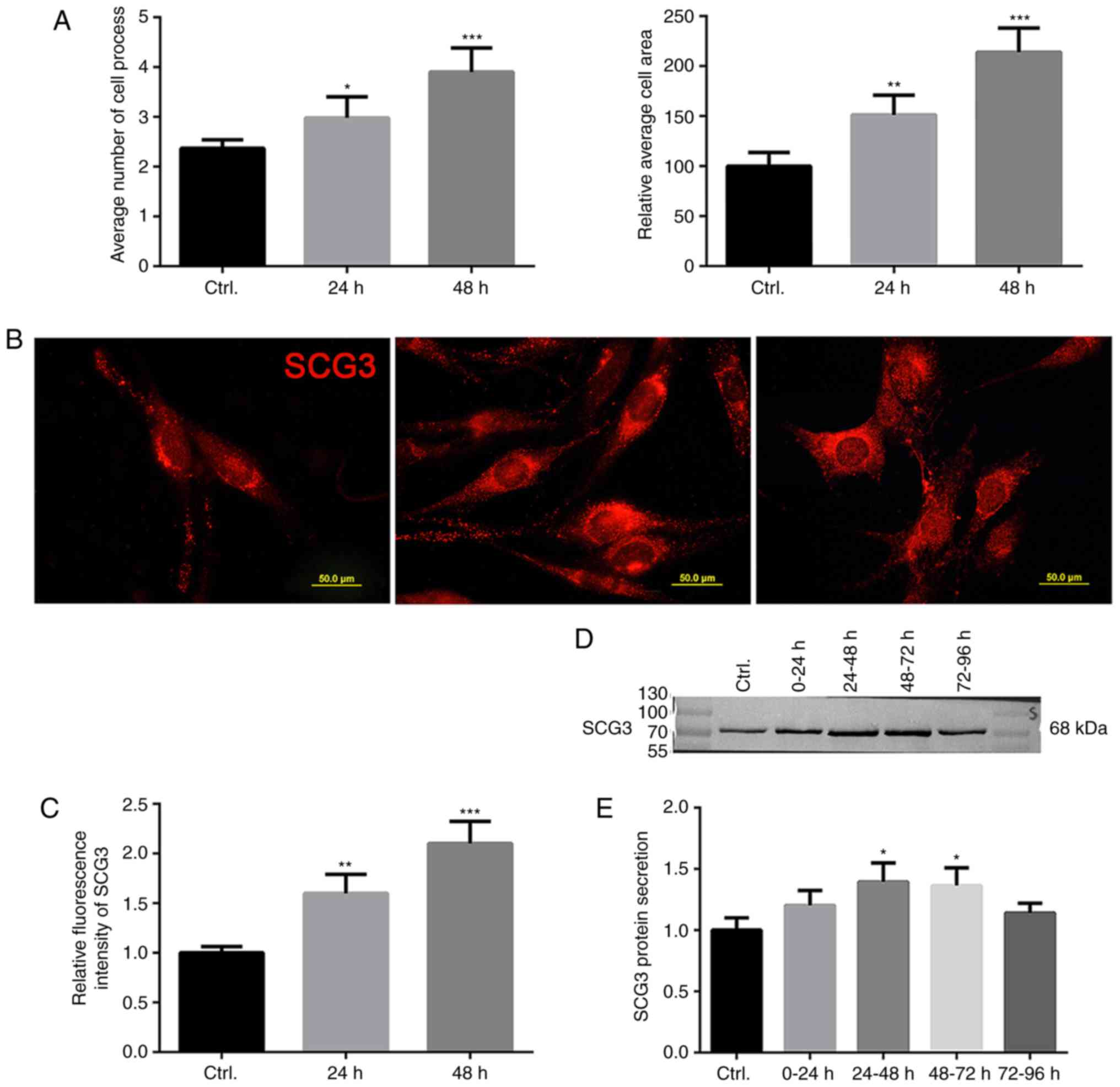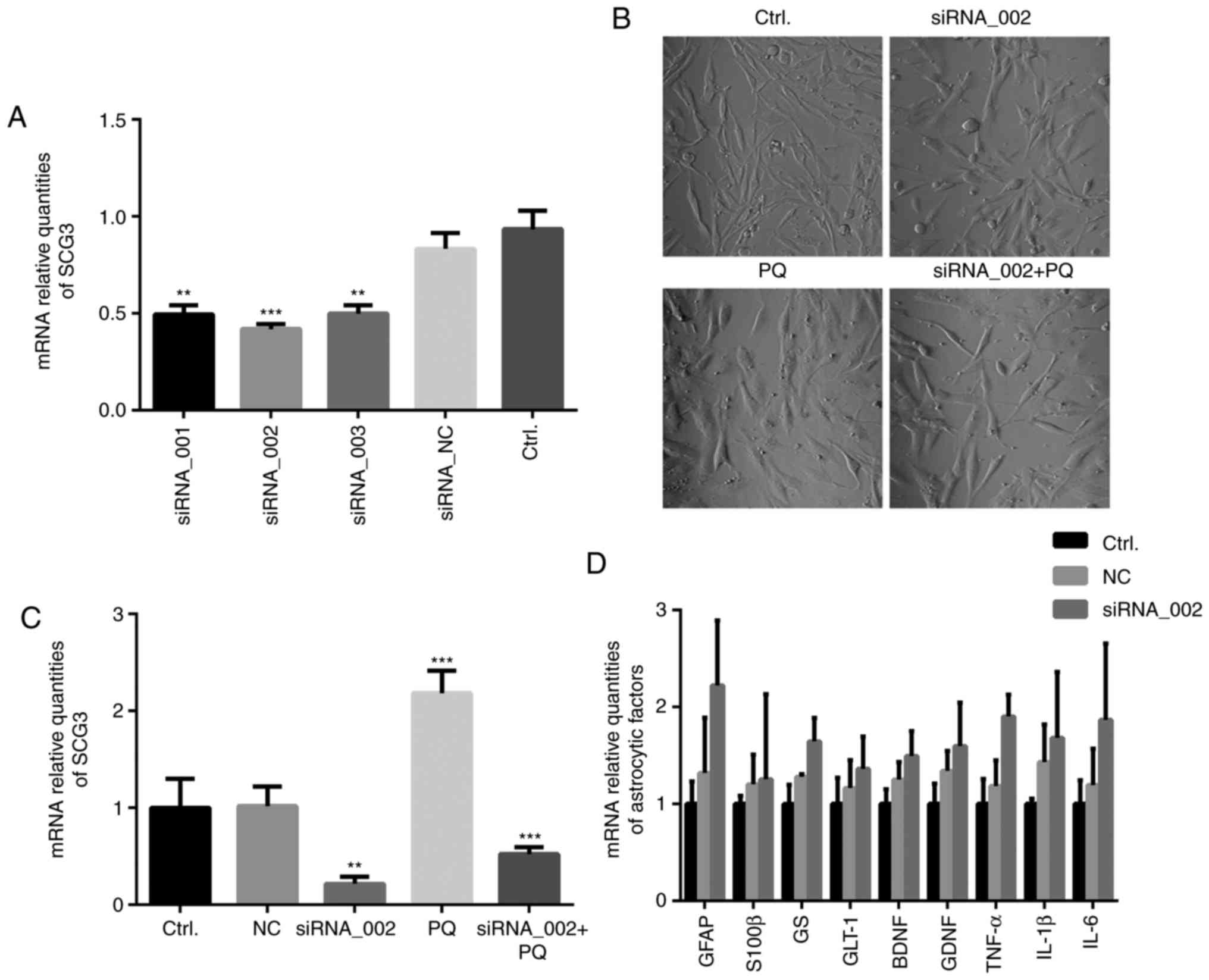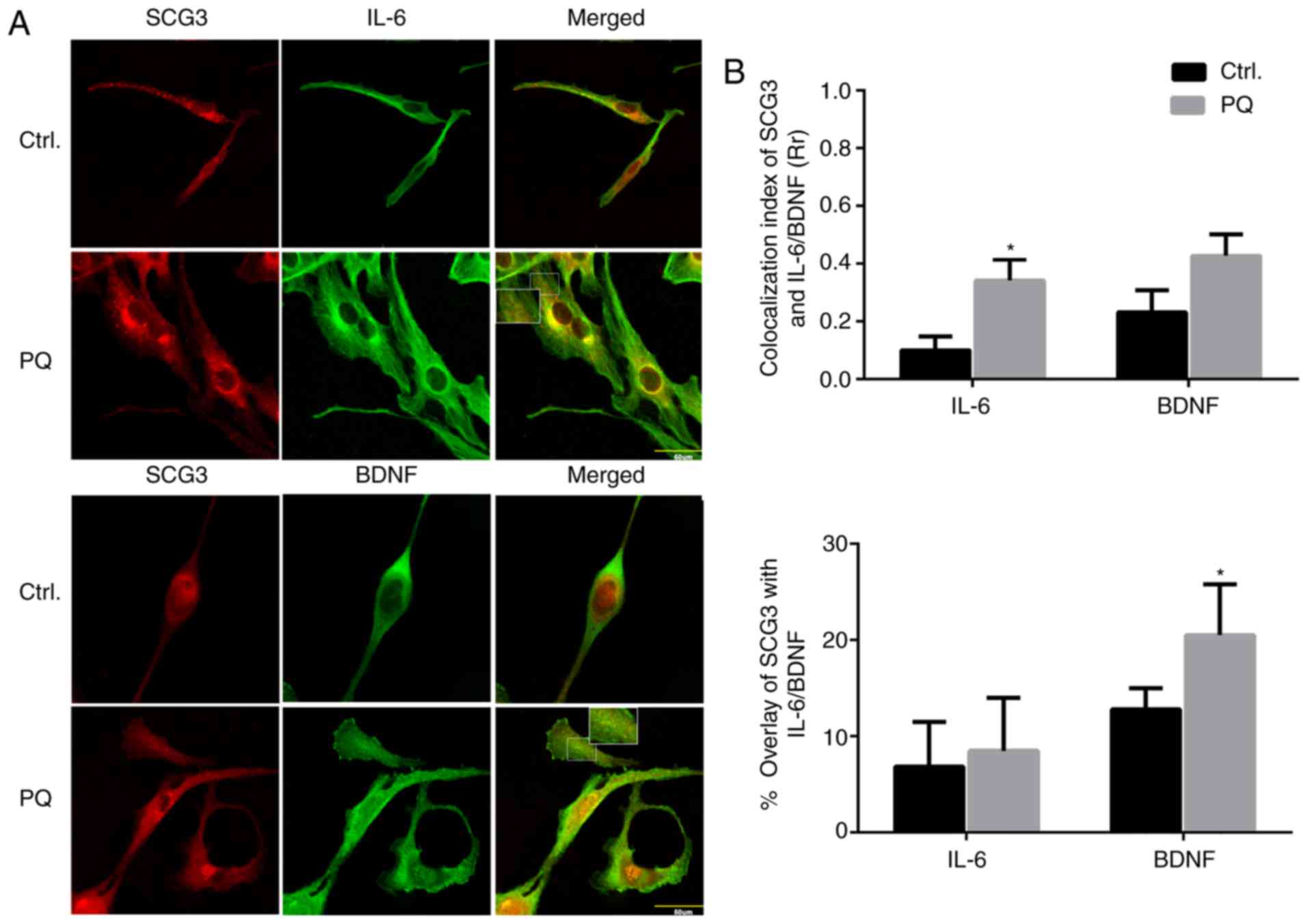|
1
|
Parpura V, Heneka MT, Montana V, Oliet SH,
Schousboe A, Haydon PG, Stout RF Jr, Spray DC, Reichenbach A,
Pannicke T, et al: Glial cells in (patho)physiology. J Neurochem.
121:4–27. 2012. View Article : Google Scholar : PubMed/NCBI
|
|
2
|
Schousboe A and Waagepetersen HS: Role of
astrocytes in glutamate homeostasis: Implications for
excitotoxicity. Neurotox Res. 8:221–225. 2005. View Article : Google Scholar : PubMed/NCBI
|
|
3
|
Yu B, Changsheng Y, Wenjun Z, Ben L, Hai
Q, Jing M, Guangwei X, Shuhua W, Fang L, Aschner M and Rongzhu L:
Differential protection of pre-versus post-treatment with curcumin,
Trolox, and N-acetylcysteine against acrylonitrile-induced
cytotoxicity in primary rat astrocytes. Neurotoxicology. 51:58–66.
2015. View Article : Google Scholar : PubMed/NCBI
|
|
4
|
Ben Haim L, Carrillo-de Sauvage MA,
Ceyzeriat K and Escartin C: Elusive roles for reactive astrocytes
in neurodegen-erative diseases. Front Cell Neurosci. 9:2782015.
View Article : Google Scholar
|
|
5
|
Eng LF, Ghirnikar RS and Lee YL: Glial
fibrillary acidic protein: GFAP-thirty-one years (1969–2000).
Neurochem Res. 25:1439–1451. 2000. View Article : Google Scholar : PubMed/NCBI
|
|
6
|
Zamanian JL, Xu L, Foo LC, Nouri N, Zhou
L, Giffard RG and Barres BA: Genomic analysis of reactive
astrogliosis. J Neurosci. 32:6391–6410. 2012. View Article : Google Scholar : PubMed/NCBI
|
|
7
|
Taupenot L, Harper KL and O'Connor DT: The
chromo-granin-secretogranin family. N Engl J Med. 348:1134–1149.
2003. View Article : Google Scholar : PubMed/NCBI
|
|
8
|
Bartolomucci A, Possenti R, Mahata SK,
Fischer-Colbrie R, Loh YP and Salton SR: The extended granin
family: Structure, function, and biomedical implications. Endocr
Rev. 32:755–797. 2011. View Article : Google Scholar : PubMed/NCBI
|
|
9
|
van Luijn MM, van Meurs M, Stoop MP,
Verbraak E, Wierenga-Wolf AF, Melief MJ, Kreft KL, Verdijk RM, 't
Hart BA, Luider TM, et al: Elevated expression of the cerebrospinal
fluid disease markers chromogranin a and clusterin in astrocytes of
multiple sclerosis white matter lesions. J Neuropathol Exp Neurol.
75:86–98. 2016. View Article : Google Scholar
|
|
10
|
Hosaka M and Watanabe T: Secretogranin
III: A bridge between core hormone aggregates and the secretory
granule membrane. Endocr J. 57:275–286. 2010. View Article : Google Scholar : PubMed/NCBI
|
|
11
|
Hosaka M, Suda M, Sakai Y, Izumi T,
Watanabe T and Takeuchi T: Secretogranin III binds to cholesterol
in the secretory granule membrane as an adapter for chromogranin A.
J Biol Chem. 279:3627–3634. 2004. View Article : Google Scholar
|
|
12
|
Hosaka M, Watanabe T, Sakai Y, Kato T and
Takeuchi T: Interaction between secretogranin III and
carboxypeptidase E facilitates prohormone sorting within secretory
granules. J Cell Sci. 118:4785–4795. 2005. View Article : Google Scholar : PubMed/NCBI
|
|
13
|
Coppinger JA, Cagney G, Toomey S,
Kislinger T, Belton O, McRedmond JP, Cahill DJ, Emili A, Fitzgerald
DJ and Maguire PB: Characterization of the proteins released from
activated platelets leads to localization of novel platelet
proteins in human atherosclerotic lesions. Blood. 103:2096–2104.
2004. View Article : Google Scholar
|
|
14
|
Prasad P, Yanagihara AA, Small-Howard AL,
Turner H and Stokes AJ: Secretogranin III directs secretory vesicle
biogenesis in mast cells in a manner dependent upon interaction
with chro-mogranin A. J Immunol. 181:5024–5034. 2008. View Article : Google Scholar : PubMed/NCBI
|
|
15
|
Paco S, Pozas E and Aguado F:
Secretogranin III is an astrocyte granin that is overexpressed in
reactive glia. Cereb Cortex. 20:1386–1397. 2010. View Article : Google Scholar
|
|
16
|
Li F, Tian X, Zhou Y, Zhu L, Wang B, Ding
M and Pang H: Dysregulated expression of secretogranin III is
involved in neurotoxin-induced dopaminergic neuron apoptosis. J
Neurosci Res. 90:2237–2246. 2012. View Article : Google Scholar : PubMed/NCBI
|
|
17
|
Teunissen CE, Koel-Simmelink MJ, Pham TV,
Knol JC, Khalil M, Trentini A, Killestein J, Nielsen J, Vrenken H,
Popescu V, et al: Identification of biomarkers for diagnosis and
progression of MS by MALDI-TOF mass spectrometry. Mult Scler.
17:838–850. 2011. View Article : Google Scholar : PubMed/NCBI
|
|
18
|
Teyssier JR, Ragot S, Chauvet-Gélinier JC,
Trojak B and Bonin B: Activation of a ΔFOSB dependent gene
expression pattern in the dorsolateral prefrontal cortex of
patients with major depressive disorder. J Affect Disord.
133:174–178. 2011. View Article : Google Scholar : PubMed/NCBI
|
|
19
|
Berry C, La Vecchia C and Nicotera P:
Paraquat and Parkinson's disease. Cell Death Differ. 17:1115–1125.
2010. View Article : Google Scholar : PubMed/NCBI
|
|
20
|
Nakagawa T and Schwartz JP: Gene
expression profiles of reactive astrocytes in dopamine-depleted
striatum. Brain Pathol. 14:275–280. 2004. View Article : Google Scholar : PubMed/NCBI
|
|
21
|
Sandström J, Broyer A, Zoia D, Schilt C,
Greggio C, Fournier M, Do KQ and Monnet-Tschudi F: Potential
mechanisms of development-dependent adverse effects of the
herbicide paraquat in 3D rat brain cell cultures. Neurotoxicology.
60:116–124. 2017. View Article : Google Scholar : PubMed/NCBI
|
|
22
|
Li F, Tian X, Zhan X, Wang B, Ding M and
Pang H: Clathrin-dependent uptake of paraquat into SH-SY5Y cells
and its internalization into different subcellular compartments.
Neurotox Res. 32:204–217. 2017. View Article : Google Scholar : PubMed/NCBI
|
|
23
|
Zhan X, Li F, Chu Q and Pang H: Effects of
PQ's cytotoxicity on secretory vesicles in astroglia: Expression
alternation of secretogranin II and its potential interaction with
intracellular factors. Biochem Biophys Res Commun. 497:675–682.
2018. View Article : Google Scholar : PubMed/NCBI
|
|
24
|
Noble MA: ISO 15190:2003 medical
laboratories-requirements for safety. EJIFCC. 15:141–143.
2004.PubMed/NCBI
|
|
25
|
Livak KJ and Schmittgen TD: Analysis of
relative gene expression data using real-time quantitative PCR and
the 2(-Delta Delta C(T)) method. Methods. 25:402–408. 2001.
View Article : Google Scholar
|
|
26
|
Sazonova OV, Lee KL, Isenberg BC, Rich CB,
Nugent MA and Wong JY: Cell-cell interactions mediate the response
of vascular smooth muscle cells to substrate stiffness. Biophys J.
101:622–630. 2011. View Article : Google Scholar : PubMed/NCBI
|
|
27
|
Verkhratsky A, Matteoli M, Parpura V,
Mothet JP and Zorec R: Astrocytes as secretory cells of the central
nervous system: Idiosyncrasies of vesicular secretion. EMBO J.
35:239–257. 2016. View Article : Google Scholar : PubMed/NCBI
|
|
28
|
John GR, Lee SC, Song X, Rivieccio M and
Brosnan CF: IL-1-regulated responses in astrocytes: Relevance to
injury and recovery. Glia. 49:161–176. 2005. View Article : Google Scholar
|
|
29
|
Niranjan R, Nath C and Shukla R: The
mechanism of action of MPTP-induced neuroinflammation and its
modulation by melatonin in rat astrocytoma cells, C6. Free Radic
Res. 44:1304–1316. 2010. View Article : Google Scholar : PubMed/NCBI
|
|
30
|
Adzic M, Stevanovic I, Josipovic N, Laketa
D, Lavrnja I, Bjelobaba IM, Bozic I, Jovanovic M, Milosevic M and
Nedeljkovic N: Extracellular ATP induces graded reactive response
of astrocytes and strengthens their antioxidative defense in vitro.
J Neurosci Res. 95:1053–1066. 2017. View Article : Google Scholar
|
|
31
|
Pekny M, Levéen P, Pekna M, Eliasson C,
Berthold CH, Westermark B and Betsholtz C: Mice lacking glial
fibrillary acidic protein display astrocytes devoid of intermediate
filaments but develop and reproduce normally. EMBO J. 14:1590–1598.
1995. View Article : Google Scholar : PubMed/NCBI
|
|
32
|
Kraft AW, Hu X, Yoon H, Yan P, Xiao Q,
Wang Y, Gil SC, Brown J, Wilhelmsson U, Restivo JL, et al:
Attenuating astrocyte activation accelerates plaque pathogenesis in
APP/PS1 mice. FASEB J. 27:187–198. 2013. View Article : Google Scholar :
|
|
33
|
Calabrese F, Rossetti AC, Racagni G, Gass
P, Riva MA and Molteni R: Brain-derived neurotrophic factor: A
bridge between inflammation and neuroplasticity. Front Cell
Neurosci. 8:4302014. View Article : Google Scholar
|
|
34
|
Huang S, Tong H, Lei M, Zhou M, Guo W, Li
G, Tang X, Li Z, Mo M, Zhang X, et al: Astrocytic glutamatergic
transporters are involved in Aβ-induced synaptic dysfunction. Brain
Res. 1678:129–137. 2018. View Article : Google Scholar
|
|
35
|
Plá V, Paco S, Ghezali G, Ciria V, Pozas
E, Ferrer I and Aguado F: Secretory sorting receptors
carboxypeptidase E and secretogranin III in amyloid β-associated
neural degeneration in Alzheimer's disease. Brain Pathol.
23:274–284. 2013. View Article : Google Scholar
|
|
36
|
Potokar M, Stenovec M, Kreft M, Kreft ME
and Zorec R: Stimulation inhibits the mobility of recycling
peptidergic vesicles in astrocytes. Glia. 56:135–144. 2008.
View Article : Google Scholar
|
|
37
|
Fujita Y, Katagi J, Tabuchi A, Tsuchiya T
and Tsuda M: Coactivation of secretogranin-II and BDNF genes
mediated by calcium signals in mouse cerebellar granule cells.
Brain Res Mol Brain Res. 63:316–324. 1999. View Article : Google Scholar : PubMed/NCBI
|
|
38
|
Kuczewski N, Porcher C, Ferrand N,
Fiorentino H, Pellegrino C, Kolarow R, Lessmann V, Medina I and
Gaiarsa JL: Backpropagating action potentials trigger dendritic
release of BDNF during spontaneous network activity. J Neurosci.
28:7013–7023. 2008. View Article : Google Scholar : PubMed/NCBI
|
|
39
|
Lou H, Kim SK, Zaitsev E, Snell CR, Lu B
and Loh YP: Sorting and activity-dependent secretion of BDNF
require interaction of a specific motif with the sorting receptor
carboxypeptidase E. Neuron. 45:245–255. 2005. View Article : Google Scholar : PubMed/NCBI
|
|
40
|
Cawley NX, Rathod T, Young S, Lou H, Birch
N and Loh YP: Carboxypeptidase E and Secretogranin III coordinately
facilitate efficient sorting of proopiomelanocortin to the
regulated secretory pathway in AtT20 cells. Mol Endocrinol.
30:37–47. 2016. View Article : Google Scholar :
|
|
41
|
Moller JC, Kruttgen A, Burmester R, Weis
J, Oertel WH and Shooter EM: Release of interleukin-6 via the
regulated secretory pathway in PC12 cells. Neurosci Lett.
400:75–79. 2006. View Article : Google Scholar : PubMed/NCBI
|















